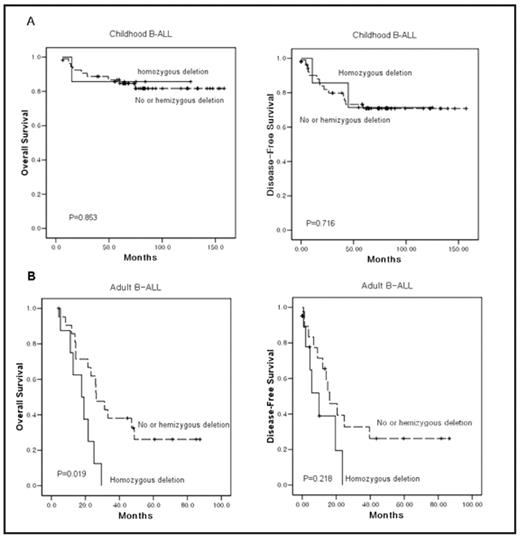Abstract
Backgrounds: The biologic characteristics of childhood acute lymphoblastic leukemia (ALL) is different from those of adult ALL. Tumor suppressor genes, p16, p14, and p15 gene are inactivated either by promoter methylation, deletion or mutation, however, in leukemia, promoter methylation and deletion are the main mechanisms of inactivation.
Aims: To compare the alteration status of p16, p14, and p15 gene in childhood and adult ALL, we analyzed the incidences and the prognostic significances of deletion and hypermethylation of p16, p14, and p15 in childhood and adult B-ALL. The association between alterations of those genes and known cytogenetic prognostic factors (BCR-ABL, TEL-AML, MLL rearrangement, and numerical changes) were also assessed.
Methods: A total of 91 newly diagnosed B-ALL patients (61 children, 30 adults) were studied. Interphase fluorescent in situ hybridization study (p16, BCR-ABL, TEL-AML, MLL) and methylation specific PCR were performed using bone marrow mononuclear cells. Numerical changes were assessed by FISH and chromosome analysis. Chi-square test, Fisher’s exact test, Kaplan and Meier method and Cox proportional hazards regression were applied for statistical analysis.
Results: The frequencies of homozygous deletion of p16, p14, and p15 were 11.5% in children and 30.0% in adult, showing higher incidence in adults (p=0.029). In overall survival study, homozygous deletion was associated with the worse prognosis in adults (Fig 1, p=0.019), but not in childhood. The incidences of promoter methylation of p16, p14, and p15 were as follows: 34.4%, 14.8%, and 34.4% in children; 26.7%, 10.0%, and 40.0% 26.7% in adults, respectively, with no statistical difference between two groups. No significant association was observed between deletion and hypermethylation. Childhood ALL showed inactivation of p16 (39.3%), p14 (24.6%), and p15 (42.6%), while adult ALL showed inactivation of p16 (46.7%), p14 (33.3%), and p15 (56.7%), with the same order of frequencies, but with higher tendency of methylation in adult ALL. In p14 unmethylated adults, the homozygous deletion had adverse effect on overall survival (OS) (p=0.036). There were no significant association between chromosomal aberrations and promoter methylation in childhood and adult ALL. The children with sole MLL rearrangement showed poorer disease free survival (DFS) than those with sole homozygous deletion with low statistical significance (p=0.059). Homozygous deletion was translated into poor prognosis in OS in adults without MLL rearrangement (p=0.011). Adult with normal karyotype showed shorter OS when accompanied by homozygous deletion, although p value was 0.051.
Conclusions: We performed a comprehensive analysis of deletion and hypermethylation of p16, p14, and p15 genes in both childhood and adult B-ALL. Homozygous deletion was more frequent in adults, showing association with shorter OS in adults, but not in children. This difference of distribution and prognostic value between childhood and adult ALL could be one of the explanations for the disparity of clinical outcome. Our results suggest that homozygous deletion is an independent prognostic factor in adult ALL.
Table 1. Deletion and methylation profiles of p16, p14, and p15, and their prognostic siginificances
| . | . | P16, P14, and P15 Deletion . | P16 Methylation . | P14 Methylation . | P15 Methylation . |
|---|---|---|---|---|---|
| *P: p value by multivariate analysis | |||||
| †OS: Overall survival | |||||
| ‡DPS: Disease free survival | |||||
| Childhood | Frequency | 11.5% | 34.4% | 14.8% | 34.4% |
| *P (†OS) | 0.853 | 0.979 | 0.651 | 0.591 | |
| P (‡DPS) | 0.716 | 0.956 | 0.809 | 0.977 | |
| Adults | Frequency | 30.0% | 26.7% | 10.0% | 40.0% |
| P (OS) | 0.019 | 0.151 | 0 892 | 0.330 | |
| P (DPS) | 0.218 | 0.382 | 0.079 | 0.760 | |
| . | . | P16, P14, and P15 Deletion . | P16 Methylation . | P14 Methylation . | P15 Methylation . |
|---|---|---|---|---|---|
| *P: p value by multivariate analysis | |||||
| †OS: Overall survival | |||||
| ‡DPS: Disease free survival | |||||
| Childhood | Frequency | 11.5% | 34.4% | 14.8% | 34.4% |
| *P (†OS) | 0.853 | 0.979 | 0.651 | 0.591 | |
| P (‡DPS) | 0.716 | 0.956 | 0.809 | 0.977 | |
| Adults | Frequency | 30.0% | 26.7% | 10.0% | 40.0% |
| P (OS) | 0.019 | 0.151 | 0 892 | 0.330 | |
| P (DPS) | 0.218 | 0.382 | 0.079 | 0.760 | |
Kaplan-Meier curve for childhood and adult B-ALL patients. P value was obtained by multivariate analysis using Cox hazard regression model. (A) Childhood B-ALL (B) B. Adult B-ALL
Kaplan-Meier curve for childhood and adult B-ALL patients. P value was obtained by multivariate analysis using Cox hazard regression model. (A) Childhood B-ALL (B) B. Adult B-ALL
Disclosures: No relevant conflicts of interest to declare.
Author notes
Corresponding author


